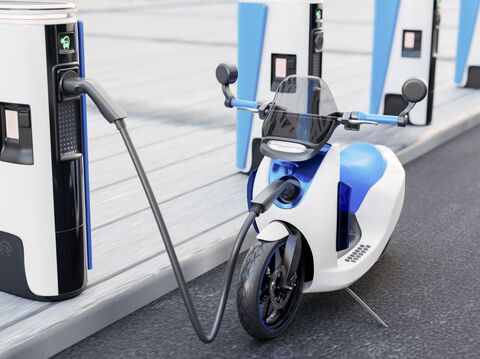Top 5 Fundamental Changes in EV Operating Model

The EV Operating Model is yet another example of the ever-evolving technology sphere around us. While the roads are still flooded with petrol or diesel vehicles, the spike in electric vehicles cannot be underestimated. As per the data collected, there were more than 10 million electric vehicles on the streets in 2020.
Even a global pandemic couldn’t curb the expansion of electric vehicles— with a remarkable rise in the registration of electric vehicles in 2020 during the massive COVID outbreak and lockdown. While China is usually in competition for the biggest EV market, in 2020, Europe stood out as a significant stakeholder in the EV markets. Data indicate that the EV market will rise to 26.8% CAGR by 2030.

The success of the EV operating model can be studied by understanding the key reasons contributing to its market expansion. At GrowthJockey, technological advancement, availability of trending models, consumer awareness and sustainability are a few reasons for the success of the EV operating model. Moreover, the rise in sustainable practices across different industries has pushed the automotive sector to take relevant steps.
To delve deeper into the concept and understand the present EV Operating scenario, here are the top 5 fundamental changes in EV operating model changes to incorporate.
1. Changing Customer Demands Topple the Insurance Schemes
Companies focus primarily on providing an integrated experience to consumers, thus, putting insurance as an added service. As a result, insurers need to explore the digital environment and use digital liabilities best to improve customer experience. In most cases, an EV customer opts for an insurance operating model. There has been a massive increase in the purchase of insurance, often served by industrial giants from the banking, telecommunication or media sectors.
On the other hand, there has been a substantial increase in revenues, especially in the retail and automotive sectors. While digitalisation is considered the key reason behind the success of the EV model, digital giants increase their income by five times of companies. Also, the shareholders observe a double increase in the rates.
A rise in digital assets has pushed the growth of the operating model. On the contrary, it has also increased the expectation of consumers. As a result, only a few insurers can cope with the changing scenario. We at Growth Jockey aim to help to level up businesses by using the best technological resources.
2. External Influence on the Insurance Market
As the number of insurance takers has increased, external influencing bodies offering insurance take it as an opportunity. Moreover, the post-pandemic economic hindrance has pushed insurance companies to expand their scope of work and outreach different possible sectors of the industry. External insurance providers come with a customer-centric approach. They possess great digital sources and come with relationship-building skills. As a result, quick approaches are taken to woo customers through products and services.
To tackle this problem, EV companies have tried collaborating or partnering with external insurance companies. Amazon and Ikea are the latest examples of such partnerships. This benefits both parties, ensuring the safeguarding of the spending cost of electric vehicle companies.
3. The subsequent rise in consumer spending with government stabilising support
As per data, around USD 120 billion was spent by consumers on electric vehicle purchases. This number is significantly higher than the spending in the year 2019 and before. The sales were 50 per cent higher than the ones obtained in 2019. To break it down, 41 per cent was the increase in sales, and the remaining 6 per cent was the increment in average EV prices.
Due to the currency difference between China, Asia and Europe, the maximum sales were witnessed by European EV sellers. In 2020, the average BEV price was approximately USD 40,000, whereas the average PHEV price accounted for USD 50,000. With such numbers, the business model is expected to succeed in the coming years.
Moving on, let’s talk about Government spending. In 2020, governments across the globe grabbed USD 14 billion in the form of tax deductions and incentives. These numbers were 25 per cent higher than the previous years. Irrespective of these numbers, the total EV spending has decreased from 20 per cent in 2015 to 10 per cent in 2020.
The pandemic-stricken economy pushed countries to provide incentive schemes strategy to drive the EV segment. Similarly, China and Europe introduced price caps. These caps indicate the number of subsidies provided for EVs with costs above a fixed threshold. As a result, the prices of EVs fell in both nations. The BEV cars in China were sold at 3% lower rates than in 2019. Moreover, the PHEV cars were sold at lower speeds too.
4. Launch of exciting models
Several market leading strategies have been adopted to push EV sales. Among other fundamental changes, the automotive sector has introduced new models with better technology implementation. In 2020, there were 370 electric car models available for purchase. This number is 40 per cent higher than in 2019. Europe witnessed the most significant jump in electric car models in 2020.
Among other models, SUV or the Sport Utility Vehicle accounts for a majority of car models available. More than 55 per cent of available EV models are SUVs and pick-ups. The increase in sales of SUVs has contributed to the popularity of the operating model, thus, clearly a pathway for future consumerism. Moreover, operating models for insurance companies account for a better reach.
5. IES’s Sustainable Development Criteria
EV manufacturers are aligning their electrification deliverables with the IEA’s Sustainable Development Scenario guidelines. A significant number of EV manufacturers have altered their outlook beyond 2025. Moreover, some of the largest OEMs have already announced their modified electrification deliverable for 2030 and beyond.
On the other hand, several OEMs have shared their plans to reshape their product lines and manufacture only electric vehicles. The rising voices for sustainability and environment-friendly alternative have pushed these manufacturers to take the right step. Automotive giants like Volvo, Ford, General Motors, Volkswagen and Stellantis have displayed great enthusiasm while declaring the production of electric vehicles in the coming years. The OEMs announcements are expected to bring 55 to 72 million sales of electric LDVs or Light Duty Vehicles.
EV Operating Models hold a promising future
Several reasons portray the promising future of Electric Vehicles. Reduced carbon dioxide emission and sustainability top the list. By switching to EVs, countries like India can reduce their carbon dioxide production by one Giga tonne by 2030. Not just South Asian countries but the entire world has been toppling between the rise in population and subsequent climatic disturbance. Investing in EVs can be a positive solution to the current problems.
Ultimately, it is up to the automotive sector manufacturers to understand their unique ways of serving their consumer and customer segments. Consumer interests have increased significantly, making way for updated OEMs, Insurance opportunities and dealerships. To make the most of the rising popularity of EVs, the stakeholders must examine the present scenario and business model from a broader perspective. Providing a sustained position to the business model must be one of the critical objectives of the EV automotive sectors of different nations.
GrowthJockey helps you aim for that vision. We assist in highlighting essential duties and a business plan by helping you choose the most influential operating model for your business.
To guarantee strategic and operational alignment, we routinely attempt to understand external needs and contrast them with your team’s and board’s feedback. Growth Jockey considers your company's maturity level when determining where to spend for the most return within a strategic timeline.
At GrowthJockey, we are fully committed to developing customised operating models that effectively address the critical challenges faced by our clients across various industries. Irrespective of your company's size, whether it's a small-scale enterprise or a large corporation, you can now benefit from our tailored solutions.
Take the decisive step towards unlocking the next level of growth for your brand by reaching out to us today!








